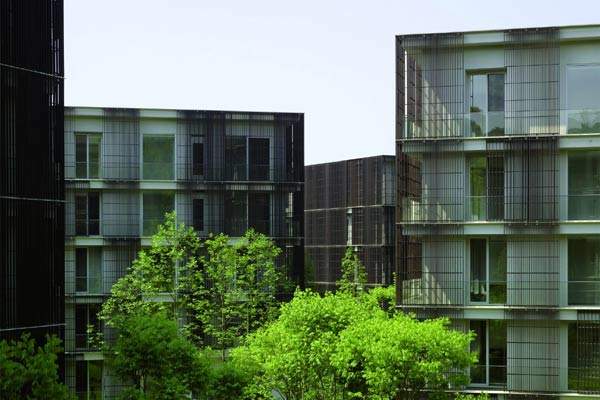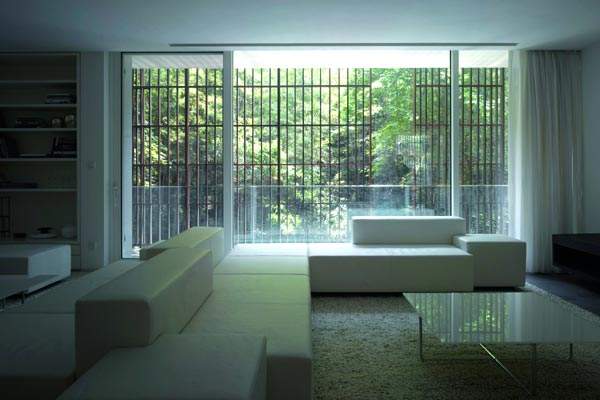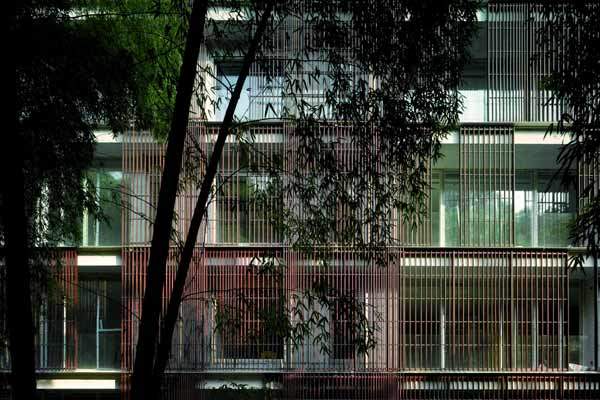A small valley bordered by a dense bamboo forest forms the site for this luxury housing development, situated near the Qiang Tang River in Hangzhou, south-eastern China. Twelve individual volumes, with five apartments each, are arranged in a chessboard pattern to allow the maximum amount of open space for each building. Through the planting of new vegetation, each apartment building is set in its own clearing in the forest.
The project was designed by David Chipperfield Architects. Construction of the project started in 2004 and was completed in 2008. The total area of the building is 23,500m².
The buildings adapt to the topography, creating a flowing landscape through a slight turning of the blocks. The grounds will be accessed from the southern entrance via a network of lanes. All the buildings are linked to an underground car park, enabling the site to remain free from vehicles above ground.
The Lianghzu Culture Museum lies along with the archaeological museum. The idyllic natural surroundings of the buildings enhance charm and the luxury of living. All the apartments provide stunning view of beautiful landscape and private gardens.
Ninetree village is the only residential project in China to receive the Royal Institute of British Architects (RIBA) international award for its architectural standards and environmentally sustainable design, in 2009.
Ninetree Village buildings
Within the development there are six types of building, differing in size and floor plan depending on the location, view and light conditions. The individual apartment buildings contain five generously proportioned apartments, each accommodating a full floor of approximately 400m².
The floor plan concept creates a flowing interior space defined by solid elements that accommodate auxiliary functions. The selection of materials for the living and sleeping areas provides an elegant, calm atmosphere, while the enclosed elements are envisaged as cabinets using precious traditional materials.
The loggia zone, which runs around the whole building, provides a transition area between the interior living space and the surrounding nature. Based on a traditional principle of Chinese housing, an exterior skin using wooden elements protects the privacy of the residents.
This skin differs in density, depending on the interior functions, sunlight and the conditions of the site. Moveable elements allow the resident to further decide on the degree of privacy desired.
A clubhouse with an outdoor pool is located at the northern tip of the site.
This small building follows the irregular shape of the steep slope of the hill, forming a retaining wall that continues to define the border of the property.
The interior is shaped like a cave carved into the hill. Skylights let natural light deep into the rooms.
In front of the clubhouse lies a raised platform with an irregular shape following the natural borders of the site. The building is made out of coloured concrete and Chinese volcanic stone.
The floors are made of natural stone and built-in furniture is made of wood. Materials in the buildings also include silk and handcrafted manufacturing.
Interior (kitchen) design
The buildings have about 60 high quality kitchens built with bulthaup b3 system. The b3 functional walls serve as an integrating context and as a carrier system for cabinets, countertops, built-in appliances and accessories. The b3 system uses light seamless stainless steel and reduces the amount of material usage to a minimum.
The kitchens in the Ninetree village use two different b3 versions – white laminate and aluminium grey.
Contractors
Zhejiang Joyon Real Estate is the client for the Ninetree village. The structural engineering and service engineering was provided by ZSADI, Zhejiang South Architectural Design and Survey.
Levin Monsigny Landschaftsarchitekten was the landscape architect for the village. The kitchens for the Ninetree village were designed by Bulthaup, a German kitchen manufacturer.






